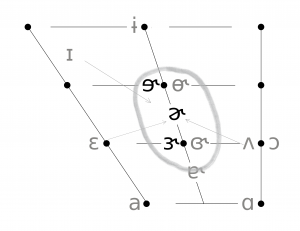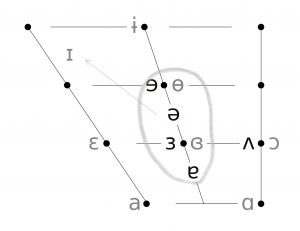10 The NURSE Lexical Set

The nurse lexical set is a part of the Free vowels group, and is only capable of being in stressed syllables. In most rhotic accents, letter is the parallel lexical set with a similar vowel quality in an unstressed syllable; in non-rhotic accents, that parallel is shared, as letter is merged with comma. In many phonologieFree vowels s of English, stressed nurse is represented by /ɝ/ in rhotic accents, and /ɜː/ in non-rhotic accents, while unstressed letter and comma are represented by schwa /ɚ/ or /ə/ respectively.

Often the phonetic vowel quality of these lexical sets are said to be the same, and what differs is merely stress. To be clear, when I discuss vowel qualities (the actual sound of the vowel) here, I mean there to be a difference between [ɚ] and [ɝ], or [ə] and [ɜ]. If you’re used to seeing these sets represented this way, this is an effect of phonemic thinking being applied to phonetic realization. As you can see from the IPA charts, schwa [ə] is meant to be more close than “reversed epsilon” [ɜ], and so should sound different. Either symbol can be used to represent comma, letter, or nurse, when appropriate, whether stressed or not. There isn’t a great deal of difference between the vowels represented by these different symbols, but I intend there to be one!
Historically, the words in the nurse set evolved from a merger of the groups of words with the short vowels /i/, /ɛ/, and /u/ before /r/ in Middle English. This is known as the First nurse Merger, which began in the 15th century. Today there are very few accents that retain the pre-merger three-way split. Some Scottish English accents do, with nurse–term–fir[1]; a few (rare) Scottish accents have been documented with a 5-way split, with further variant allophones for nurse and term. There are still other Scottish and Irish English accents which retain only a 2-way split of nurse and term (fir having been merged with term.)
The next historical change was R coalescence, where the nurse vowel and its /r/ combined into a single r-coloured or “rhotic” vowel. Later still, much of England underwent R-Dropping, where vowels before/r/ gradually lost their rhoticity between the 15th and 18th centuries. While most varieties of North American English retained the rhotic variety of English, English colonies in the Southern Hemisphere did not.
Note that some nurse words have an allophonic variation, and retain strut /ʌr/, such as hurry, worry, etc. in many accents. The Second nurse Merger occurred when the words that retain /ʌr/ were merged with nurse as we have in most accents of North America today.
As a result of all that, in many varieties of English today there are two main choices: Rhotic nurse, with a generally mid-central r-coloured vowel ranging from mid-close to mid-open [ɘ˞~ ɚ ~ ɝ ~ ɐ˞], or Non-Rhotic nurse, with a generally mid-central r-less vowel ranging from mid-close to mid-open [ɘ ~ ə ~ ɜ ~ ɐ]. Of course, there are many other variations in pronunciation, which we will get to shortly!
In many accents there are several other splits and mergers beyond what has been described here (see Mergers and Splits below).
- 🕊Free: can have a following consonant, or it can exist on its own
- in stressed syllables only (remember, the unstressed equivalent is letter.)
Spellings
er, earC, eur, ir, or, our, ur, yrrh
Words within the nurse set are spelled with all the standard vowel letters of the alphabet, apart from ‹a›. Note that ‹ear› requires a following consonant. Examples (always in stressed syllables) include: defer, earn, connoisseur, fir, attorney, journal, blur, myrrh.
Pronunciations
In discussing pronunciations of nurse, we’ll assume that we’re considering the version of nurse where term and fir sub-sets are merged. If you are Scottish or Irish and have one or both of those as different from nurse, you’ll note that the spelling of a word associated with nurse should help you somewhat to distinguish term, spelled with ‹er, earC› [ɛɚ̯], and fir spelled with ‹ir› [ɪɚ̯] (or something close to those values).
As previously discussed, there are rhotic and non-rhotic pronunciations of nurse. It is possible to have a rhotic nurse set, and yet be non-rhotic in other sets that allow for rhoticity. There are several accents that feature rhoticity in nurse, while lacking it in other settings such as letter, start, north/force, cure, square, near. This is true of many (mostly) non-rhotic accents of the US South, and non-rhotic variants of African American English. In accents where non-rhotic pronunciations are stigmatized (such as is the case in New York City), nurse is likely to become rhotic before unstressed letter does, leaving speakers with rhotic nurse and mostly non-rhotic letter.
The nurse lexical set is often transcribed with the /ɜ/ symbol in non-rhotic accents, or with /ɝ/ in rhotic accents, especially in the broad transcriptions one finds in dictionaries, and those symbols are known as reversed epsilon or reversed epsilon with right hook. I’ve always called the symbol “three”, and the rhotic version, with its little “wing,” is “flying three”. However, the vowel quality of many varieties can include more close pronunciations [ɘ / ɘ˞], ones right in the middle of the mouth [ə / ɚ], slightly more open [ɜ / ɝ], and quite open [ɐ / ɐ˞]. In describing the possibilities of nurse, I will use narrow transcription to try to give a more detailed view of how nurse might be pronounced.
It might be worth noting that, in rhotic accents, many people hear the degree of rhoticity of the nurse set more than its vowel quality as related to its height in the mouth. Learning to distinguish the two is very difficult. With strong rhoticity, vowel height is very likely to be high; with weaker, or non-rhotic pronunciations, more open articulations are more likely to be encountered.
For some varieties of English, nurse can have lip rounded variants, as in [ɞ], [ɵ] in Wales and [ɵ ~ ø] in New Zealand, where some on the South Island (Te Waipounamu) speak with the so-called Southland Burr, with rhotic [ɵ˞] for nurse and letter. The diphthong variety with [ɜɪ̯] is (was?) heard in historical New York City accents, and in the Yat accent of New Orleans; this is termed the choice–nurse merger. In Merseyside and the Greater Liverpool region in Northwestern England, a fronted version around [ɛ̠] merges nurse with square. In much of the Caribbean, nurse may be merged with strut, with a rounded [ɔ̟]; in Jamaica, however, the two sets are distinct with nurse rounded and rhotic, [ɵ˞].
Personal Pronunciation
Let’s explore your personal way of saying nurse. First, do the vowels in irk, work, lurk, jerk all rhyme? If not, you likely have a split nurse system, and so you’ll need to figure out what parts of your lexicon belong with nurse, and which with the sub-sets term or fir (hint: usually it has to do with spelling!)
Next, clarify whether you have a rhotic system, or a non-rhotic one. Do you pronounce the /r/ sound after the vowel in words like urban, search, defer, chauffeur, first, world, courtesy? If so, you are rhotic, and if not, non-rhotic. Easy.
[For non-rhotic speakers, you can skip the next two paragraphs if you’d like and go to the one following the box.]
For rhotic speakers, try to get a sense of what you do with your tongue to make your nurse vowel rhotic. What makes it have “r-coloring”? Generally, there is an approximation of the tongue near the middle of the roof of your mouth, where the (hard) palate and the velum (or soft palate) meet. This can be done in a variety of ways, with the tongue curling up towards the alveolar ridge, or up and back toward the palate, with the tongue bunched in the back of the mouth, and/or the sides of the tongue bracing itself against the bicuspids (also known as the premolars) or molars. The root of the tongue might also be drawn back into the beginning of the pharynx (aka pharyngealization). To what degree do you feel you have r-colouring? Depending on how much r-ish-ness you have, you can add one or more “wings” to indicate how rhotic it is: [ɝ ˞ ˞] would be quite rhotic! (We’ll look at another, more fine-grained option for denoting rhoticity in the Alternate Pronunciations section below.)
For all speakers, rhotic or non-, figure out whether your nurse vowel is front, central, or back. Compare it to the dress vowel (which is usually front), and to the goat or thought vowels which are back. For some speakers, if you said the words “dress…nurse…thought,” you would feel the highest point of your tongue move from front, through centre, to back. Do it with just the vowels of those three words, and you may feel it more dramatically. But some speakers may feel that their nurse vowel isn’t central, but rather front or back. That’s okay—for some speakers, that’s where it lies.
Figuring out the height of your nurse vowel can be more challenging. For those with rhoticity, the shape of the tongue to make the sound rhotic is significantly different from other non-rhotic vowels. Because rhoticity comes from an approximation (getting the tongue near the roof of the mouth without touching in order to narrow the vocal tract), part of your tongue will be “close,” while the body of the rest of your tongue maybe be quite “open” (far away from the roof of the mouth). If you don’t have rhoticity, compare the height of front and/or back vowels (looking at the IPA chart while you do it) can help to ascertain at what height, exactly, a central vowel lies. For example [ɘ] is the same height as [e] in the front, and [o] in the back. If you can lock into the “cardinal vowel” ⧉ values for those (for folks who know the numbers, that’s CV2 and CV7!), slide between them, and you should be able to feel where that central vowel is.
Identify how your nurse vowel compares with others by experimenting on your own or with a classmate, friend, coach or teacher. Try lengthening the sound of your nurse vowel, and then attempt to subtly shift its articulation around in the vowel space of your mouth—up, forwards, down, and back—in tiny increments. You should feel the top surface of your tongue arching/cupping towards/away from your alveolar (gum) ridge behind your upper front teeth. What’s the smallest noticeable change that you can make?
If your nurse vowel lies between two symbols, use diacritics to nudge the symbol around in the vowel space. If it’s…
- high, use the raised diacritic [ ə̝ ], a small T pointing up
- open, use the lowered diacritic [ ɐ̞ ], a small T pointing down
- pushed forward, use the advanced diacritic [ ɜ̟ ], a tiny plus sign +
- pulled back, use the retracted diacritic [ ɛ̠ ], a tiny minus sign –
- moved toward the middle of the mouth, towards schwa [ə], use the mid-centralized diacritic [ ɔ̽ ], a tiny x-marks-the-spot above the symbol,
- if you add lip-rounding, use the more rounded diacritic [ ʌ̹ ], a tiny ɔ, which represents the lips rounding forward (to the left).
Alternate Pronunciations
Experiment with the Word Lists, Phrases and Sentences with these rhotic central vowels:
For my own usage, I’ve tried adding a superscript number after a rhotic diacritic to rank the r-ishness on that 0-5 scale, with 0 being none and 5 as much as you can, e.g. [ɘ˞3] for a medium amount of r-quality.
Experiment with the Word Lists, Phrases & Sentences with these non-rhotic central vowels:
Experiment with the Word Lists, Phrases & Sentences with these non-rhotic non-central vowels:
As you change the articulation of the vowels’ qualities in the directions recommended, see whether that modified oral posture might inspire you to move the articulation of consonants and other vowels in the word in similar, subtle ways. Does it remind you of another accent?
Word Lists for nurse, sorted by the consonant that follows
KEY: ◾︎nurse in stressed syllable
WORD FINAL
PLOSIVES
-p
-b
-t
-d
-k
-ɡ
AFFRICATES
-tʃ
-dʒ
NASALS
-m
-n
-ŋ
FRICATIVES
-θ
-ð
-f
-v
-s
-z
-ʃ
-ʒ
In rhotic accents, vowels followed by /l/ often are affected by the “darkness,” or velarization of that /l/, which often may pull back, especially if /l/ is articulated with a particularly dark-l [ɫ]. In fact, for nurse + /ɫ/, in some accents, the dark-l may be so “strong” that the syllable breaks in two, usually inserting a schwa after the nurse vowel; thus, girl [ˈɡɝɫ] becomes [ɡɝ.əɫ].
 In order to practice this vowel without the following dark-l affecting it, try slowing down the shift from the nurse vowel to the dark-l. Rather than letting the /l/ pull back from the /r/ sound, see if your tongue tip can move forward towards the alveolar ridge, and resist the pull-back of the tongue root. Work to make the syllable not break into two. Go slowly; you could do the Consonant Chop thing by removing the /l/, then slowly and carefully adding the /l/ back in.
In order to practice this vowel without the following dark-l affecting it, try slowing down the shift from the nurse vowel to the dark-l. Rather than letting the /l/ pull back from the /r/ sound, see if your tongue tip can move forward towards the alveolar ridge, and resist the pull-back of the tongue root. Work to make the syllable not break into two. Go slowly; you could do the Consonant Chop thing by removing the /l/, then slowly and carefully adding the /l/ back in.
-l/ɫ
-ɹ
-w
Short Phrases
- The worst burnt sirloin.
- Bernie gave Bertha some perfume.
- Sherlock searched for the murderer.
- The early bird catches the worm.
- The nurses in the maternity ward helped with the birth.
- The surcharges were for alternative medicine.
- Shirley rehearsed the commercial voice over.
- Her third anniversary with her girlfriend.
- A mer-man with curly purple hair.
- A swirling, blurry painting of birches.
- The Romans worshipped the virgin goddess Minerva.
- Vern yearned to play Cyrano de Bergerac.
- Sterling K. Brown is from Missouri.
- A burglar stole the surgeon’s purse.
- A-well-a everybody’s heard about the bird: b-b-b-bird, b-bird’s a word!

Sentences
Level 1
Short with 2-3 words, underlined
- Ursula chose an immersion birth.
- I found the perfect Persian rug in Perth.
- The sunburnt girl rode the Tilt-a-Whirl.
- Squirt water at the thirsty gerbil.
- Is there tube service to Earl’s Court station, or is this the terminus?
Level 2
Short with 4-5 words, underlined
- Bert and Ernie read Yertle the Turtle to the girl.
- What did you learn, Murray, about Ernest Worthing?
- Does Hermann Miller make the world’s most ergonomic chair for work?
- Colonel Pershing served as a war observer in Tokyo.
- The merchant researched the best kerchief and skirt for Pearl.
Level 3
Medium with 3-4 words, not underlined
- Merv liked gherkins with his turkey sandwich.
- The irksome street urchin shirked his duty.
- Percy is the worst hearse driver.
- Freddie Mercury was hirsute (and kind of furry).
- Gertrude’s girdle caused her to burp.
Level 4
Hard with 4-6 words, not underlined
- Murray* Bourton first learned to shape surfboards from Gordon Merchant.
- Darren played third for Alberta’s world-class curling team.
- The Earl of Jersey preferred not to judge the gurning contest.
- Myrna, who is the worst verse speaker, didn’t rehearse enough to get cast as Lady Percy.
- Captain Kirk’s terse outburst was to urge Scotty to confer with Dr. McCoy
Mergers
nurse–strut before /r/ or Furry-Hurry Merger: Most accents in North America feature this merger (also known as the Second nurse Merger) so that words like hurry, worry, Surrey rhyme with furry, blurry, generally pronounced with [ɝ] or a variant thereof. Note how you can distinguish the morpheme of “fur” or “blur” as separate nurse words, while “hurry” is a complete word: this helps those with this merger to assess how a word like “current” or “currish” might be said in an accent that lacks the merger. “Current” is indivisible, and so it can be [ˈkʌɹənt], while “currish” has the root word “curr” (🐕), so it can be pronounced [ˈkɜɹɪʃ]. The words “occurrence” e.g. RP [əˈkʌɹəns] and “occur” [əˈkɜ] are a fairly well known exception to this rule. Several accents of the Northeastern US lack this merger, the same as most accents in the British Isles (apart from Scotland), and in the Southern Hemisphere. Scotland doesn’t have the merger of nurse vowels, so that furry sounds like hurry, with the [ʌ] vowel! If you have the distinct Furry–Hurry, try making them all match in the sentence below with your nurse vowel; if you have them merged, try matching them with your strut vowel.
-
- I’m worried that my blurry eyes can’t spot the furry bunnies’ burrows.
- The current headmaster gave me a referral to an entrepreneurial apprenticeship in Surrey.
- Furry creatures need nourishment to flourish and show love by purring.
- Chin had recurring blurriness after his flight and was worried about his current situation.
nurse–square Merger, aka Fur-Fair: In Liverpool, Ulster, and some newer accents of Dublin, square words are merged with nurse with the vowel [ɜ] or [ɝ]. (Note that for some accents in East Yorkshire, the merger goes the other way, and nurse words are merged with square, [ɛ]. Minimal pairs/homophones include were/ware, her/hair, per/pair=pare, heard/haired, curr=Kerr/care, blurred/blared, fur/fair.
Experiment with making them match using these nurse options: [ɘ˞, ɚ, ɝ, ɵ˞, ɞ˞] (rhotic), or [ɘ, ə, ɜ, ɵ, ɞ] (non-rhotic).
Make a distinction between them as nurse and square: [ɘ˞/eɚ̯, ɚ/ɛ̝ɚ̯, ɝ/ɛ̞ɚ̯, ɵ˞/e̝ɚ̯, ɞ˞/ɛ̠ɝ̯] (rhotic), or [ɘ/e, ə/ɛ, ɜ/ɛ̞ə̯, ɵ/e̞ə̯, ɜɪ̯/ɛə̯] (non-rhotic)
-
- Blair, the furry pear-shaped fairy, blurred the line with her purple hair.
- The burley, red-haired mermaid’s mare barely heard the pair of purring cats.
- They shared third place at the burger eating contest at the fairground.
- The chairman was determined to implement fairness where employment was concerned.
The choice–nurse Merger In the Historical NYC working class accent, nurse words are non-rhotic and have a closing offglide, [ɜɪ̯]. This is sometimes described as the “toity-toid street” accent[2] (as in “33rd St.”) and is now essentially extinct. There is also a nurse–choice Hypercorrection which occurs on occasion where choice words are said with the nurse vowel [ɝ], as in “You say oysters and I say ersters” in the Gershwin song “Let’s Call the Whole Thing Off”. My favourite is “soylern”, for “sirloin”, which combines both the merger and the hypercorrection. Minimal pairs include: boy/burr, oil/earl, voice/verse, oil/Earl, oily/early, Boyd/bird, coil/curl, loin/learn, poise/purrs, etc.
-
- Earl Boyd curled his lip at the bird as he coiled the oily rope.
- Emeka joined the journalism club because he enjoyed being creative with words.
- Noé gave his boyfriend the perfect gift; a trip to where they first met and a feast of oysters.
- The singer’s voice was heard echoing from a void on stage and then she emerged for the second verse.
Splits
nurse–term–fir Split: In Scottish English, which is rhotic for the most part (except when it isn’t in some accents in Glasgow and Edinburgh) there is no central nurse vowel. Rather, Scottish English maintains a three-way split with [ʌɹ] fur, [ɛɹ] fern, [ɪɹ] fir. Near Rhymes for nurse–term–fir are work/berk/shirk, curb/herb/third, hurt/alert/shirt, Turk/twerk/quirk. If you have the merger, try differentiating the three lexical sets with the trio [ʌɹ/ɛɹ/ɪɹ]; if you have the Split, try merging them using any of these nurse options: [ɘ˞, ɚ, ɝ, ɵ˞, ɞ˞] (rhotic).
Alert the quirky Turk that he’s not a “berk” when he shirks his work to twerk!
Review
- term and fir are Alternate Lexical Sets, not invented by Wells, but rather coined by others to serve their needs in describing accents beyond RP and GenAm. I represent them with small caps, but in Italics. ↵
- This accent is exemplified by The Dead End Kids in Angels with Dirty Faces (1938) https://youtu.be/7q-oU6wAx4A?t=80⧉ ↵
A vowel that can occur in a syllable that ends in a vowel, as so-called "open syllable". While it can have a consonant following it, free vowels, unlike Checked vowels, don't require it. As a result they have the potential for greater length.
Having /r/-colouring; may apply to a vowel, or to an accent that maintains historic /r/ "after" the vowel (i.e. in the spelling). The opposite of non-rhotic, which lacks /r/-colouring.
Lacking /r/-colouring in the vowel, or an accent that lacks historical /r/ "after" the vowel (esp. in the spelling). The opposite of "rhotic." "Rho" is the name for , the Greek letter that represents /r/.
The process whereby two segments combine into one, usually preserving some qualities of both original segments. For example, when /d_j/ of "would you" combine to make /dʒ/: /wʊd ju/ → /wʊdʒu/
The process whereby /r/ is omitted after a vowel (aka "post-vocalic") in "non-rhotic" speech. The lexical sets NURSE and lettER, along with the so-called "Centring Diphthongs" NEAR, SQUARE, START, NORTH, FORCE, CURE drop their /r/ sounds after the vowel. However, /r/ between two vowels is retained. Most non-rhotic accents will use a linking /r/ to connect a word final /r/ to a word that begins with a vowel as in better_off, though some accents (such as many African American, US Southern, and South African r-droppers) do not.

